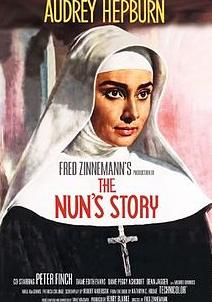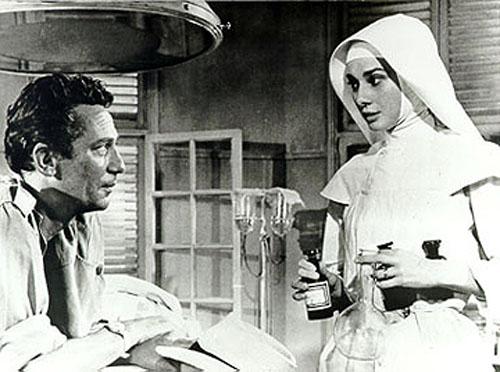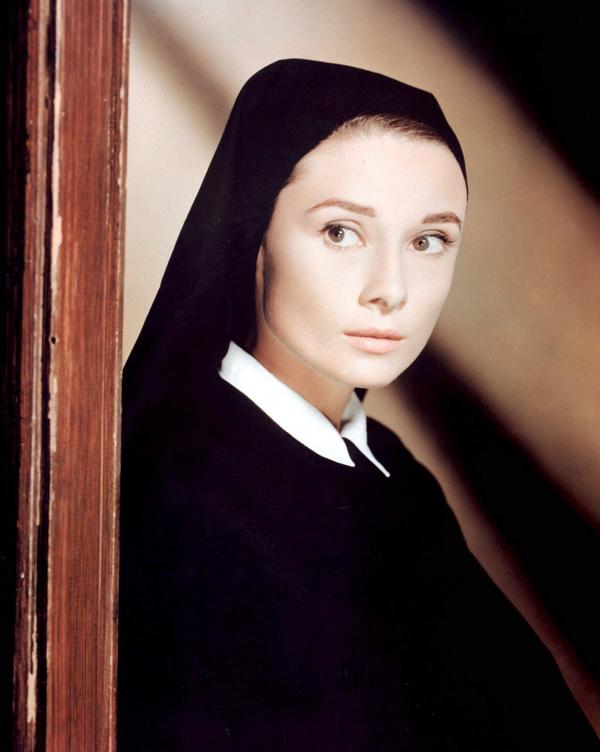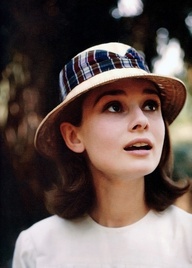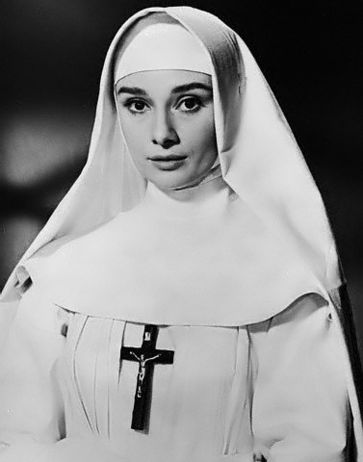 One of the things I love most about Christmas, (aside from the joy of the Saviour’s birth of course!) is the telly. The fact that it is not when I have painstakingly marked in the Radio Times all the tv shows and pictures I wish to see, but when I am mindlessly flicking through the channels, that I discover a gem of a film to watch which has just started and which I am drawn into whilst scoffing down another mince pie by the lights of the Christmas tree. Bliss. One such film I stumbled across in this way over the festive season was The Nun’s Story, starring Audrey Hepburn.
One of the things I love most about Christmas, (aside from the joy of the Saviour’s birth of course!) is the telly. The fact that it is not when I have painstakingly marked in the Radio Times all the tv shows and pictures I wish to see, but when I am mindlessly flicking through the channels, that I discover a gem of a film to watch which has just started and which I am drawn into whilst scoffing down another mince pie by the lights of the Christmas tree. Bliss. One such film I stumbled across in this way over the festive season was The Nun’s Story, starring Audrey Hepburn.
Audrey Hepburn – a truly old fashioned heart. She was beautiful, of course, but there was something in her beauty that seemed to shine from within, as if the prettiness on the outside was nothing compared to that on the inside. An inner radiance and gentleness seems to emanate from her in film and photographs. Acting was something that Audrey was good at, but never excelled in; in my view, Hepburn was put here on earth with a God-given soul of sunshine to shine into our lives through her wonderful choices of films.
One of the lesser known and probably least loved of her pictures today is The Nun’s Story, adapted from the novel by Kathleen Hulme (which I was most upset to learn is unavailable from my local library service – is it possibly out of print?) It is interesting to know that The Nun’s Story was, in its day, a box office success and well recieved by audiences and critics alike – Hepburn was nominated for an Oscar for her performance as Best Actress. Could the reason for its lack of popularity now be the lack of usual Audrey glamour she is remembered for? It isn’t a very ‘Hollywood’ film, so this could perhaps provide an explanation. However, I adore it, as Audrey’s inner radiance spills through the ‘plain’ costumes and, let’s face it, she manages to make a wimple look like the latest Hubert de Givenchy creation! Having a strange fascination with nuns – I blame Julie Andrews – and my obsession with la Hepburn; this is the perfect, understated little film for me.
The book of the same name by Kathleen Hulme was based upon the life of a Belgian nurse named Marie Louise Babets, who spent some time as a nun herself. The film is fairly faithful to the novel, though for Hollywood marketability, the sexual tension between Sister Luke (Gabby) and Dr Fortunati was ramped up in the film and is completely absent in the book.
The film tells the story of Gabrielle van der Mal, a young Belgian girl who is about to leave her family home to become a novice at a convent. Her siblings and father are clearly devastated that she is choosing this way of life, and it is clear from the beginning that both they and we, the audience, are supposed to think that while her choice of vocation is a noble one, it is not fitting for a girl of spirit such as Gabby.
Gabby’s father is a famous Belgian sugreon who has taught her all she knows about medicine and she is determined that God is calling her to serve in the Belgian Congo as a missionary nursing sister. First, she has to join the convent, and go through her training as a nun in order to then be called to do her duty where she sees it. The road to reaching her destination is littered with obstacles, tests of hers (and others’) character, and it quickly emerges that though a dedicated and thoughtful novice, the now Sister Luke is struggling with the Vow of Obedience. The departure from the convent of one of her fellow novices foreshadows her own exit from the religious life.
Sister Luke ends up studying in a school for tropical medicine and does extremely well, though she encounters a situation which reveals that convent life is no different from the outside world when politics comes into play. This is very dismaying for Sister Luke and difficult for her to accept, and is the beginning of a slow decline in her ability to live the life of a nun. At this point, however, she has her eye on the prize of serving in the Congo so she vows to be obedient, keeps her head down and hopes for the best. More disappointment awaits her though, when instead of being sent to the tropics, she is sent to a mental hospital where her nerve and her endurance are tested.
Nevertheless, Sister Luke is eventually permitted to take her final vows and to be sent to the Congo, where she confronts further disheartenment – she will not be nursing the natives, but the whites at the neighbouring hospital instead. Taking it on the chin, Sister Luke makes the best of the situation and works incredibly hard and with real flair to assist the brilliant surgeon there, Dr Fortunati (father replacement figure, anyone?) Her work is recognised as being of the highest quality and the taciturn Dr Fortunati pushes Sister Luke to the limits, as he does himself. She is widely acknowledged to be a nurse of a very high calibre, but the strain of her work schedule and the continuing spiritual struggle she undergoes is too much for her and she eventually submits to a terrible bout of tuberculosis.
She recovers, thanks to the miracle cure prepared for her by Dr Fortunati who is anxious not to lose her nursing skills, and (as is subtly implied in the film) her person too. Once more, Sister Luke finds that disappointment is looming as she is forced to return home to the mother house in Belgium as she is the only nurse who has experience with mentally ill patients. A powerful inner struggle ensues and is amplified as she is once more confined in an environment that is stifling for her, both physically, mentally and spiritually. Whereas in the Congo, she flourished, in the mother house she feels like a prisoner. This is confounded when the Second World War breaks out and she realises that any chance of returning to the Congo has now been eradicated.
In fact, the war in Europe is the nail in the coffin for Sister Luke’s time in the Convent. Grappling with the reality of the Nazi occupation, and then hearing the shock news of her father’s murder at the hands of the Germans, she can no longer cope, and then makes the decision you know that she is going to make right from the start. The final scene is particularly well done and with no words, a thousand messages are conveyed. What a film!
What I love about this picture is that it is so peaceful, the dialogue sparse, the direction is slow and spare. The whole film has an air of serenity and simplicity that echoes the environments of convents and hospitals perfectly. The acting is very good, though I do admit to finding Peter Finch’s outbursts as Dr Fortunati quite humorous and find myself chuckling away at his near belligerence! Visually it is a beautiful film to look at, I particularly enjoyed the scenes in the convent chapel during important ceremonies and masses when all the nuns were present and there are rows of immaculately lined up black and white figures amongst the beautiful symmetry of the chapel walls and arches. Breathtaking.
If you haven’t seen this film and are only familiar with Audrey’s more glamorous oeuvre such as Breakfast at Tiffany’s, then do please watch this. It’s awfully good and a proper old fashioned ripping yarn.
